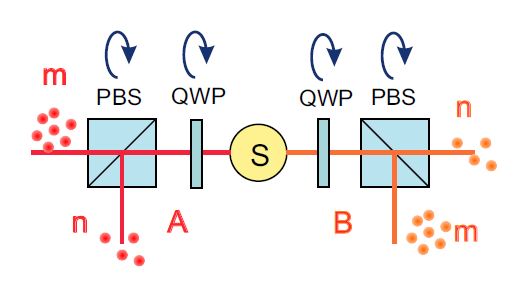Record 100,000 entangled photons detected
October 31, 2012

Quantum correlations of the macroscopic singlet Bell state. The source S emits light pulses into beams A and B (spatially separated for clarity). In each pulse, photon numbers emitted into any orthogonal polarization modes in the two beams are random but exactly equal. (Credit: Timur Sh. Iskhakov et al.)
A whopping 100,000 entangled photons have been detected for the first time, beating the previous record of just 12, New Scientist reports.
The technique could be useful for safely sharing keys used in encrypted communications.
Entangled photons have linked quantum states, such that measuring the state of one photon determines the state of the others, no matter how far apart they are.
Detecting entanglement usually involves coincidence measurement — the simultaneous detection of multiple photons in the same quantum state at different locations. But these detectors are not sensitive enough to sort out entangled from non-entangled particles when a large number of photons are involved.
So the researchers shot a laser through a device called a polarizing beam splitter, which creates two beams of photons with different polarizations. The beams were sent through a pair of barium crystals to generate photons with the same polarization but different wavelengths. These beams were then recombined to create pulses of light, each containing up to 100,000 photons.
The team split each pulse one more time into beams with two different polarizations, then used detectors to count the number of photons in each beam and calculate the difference. The values the team measured were consistent with entanglement.